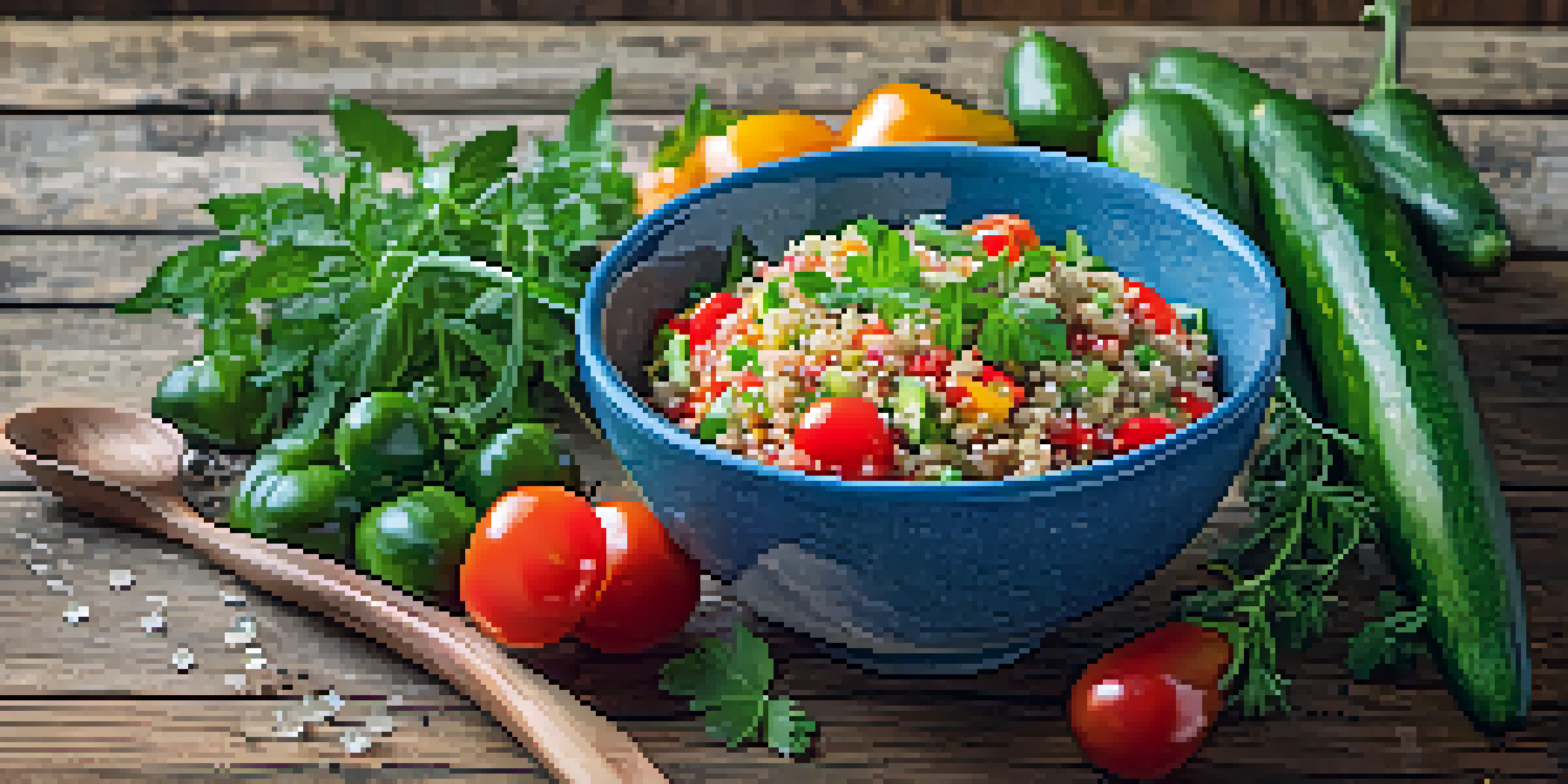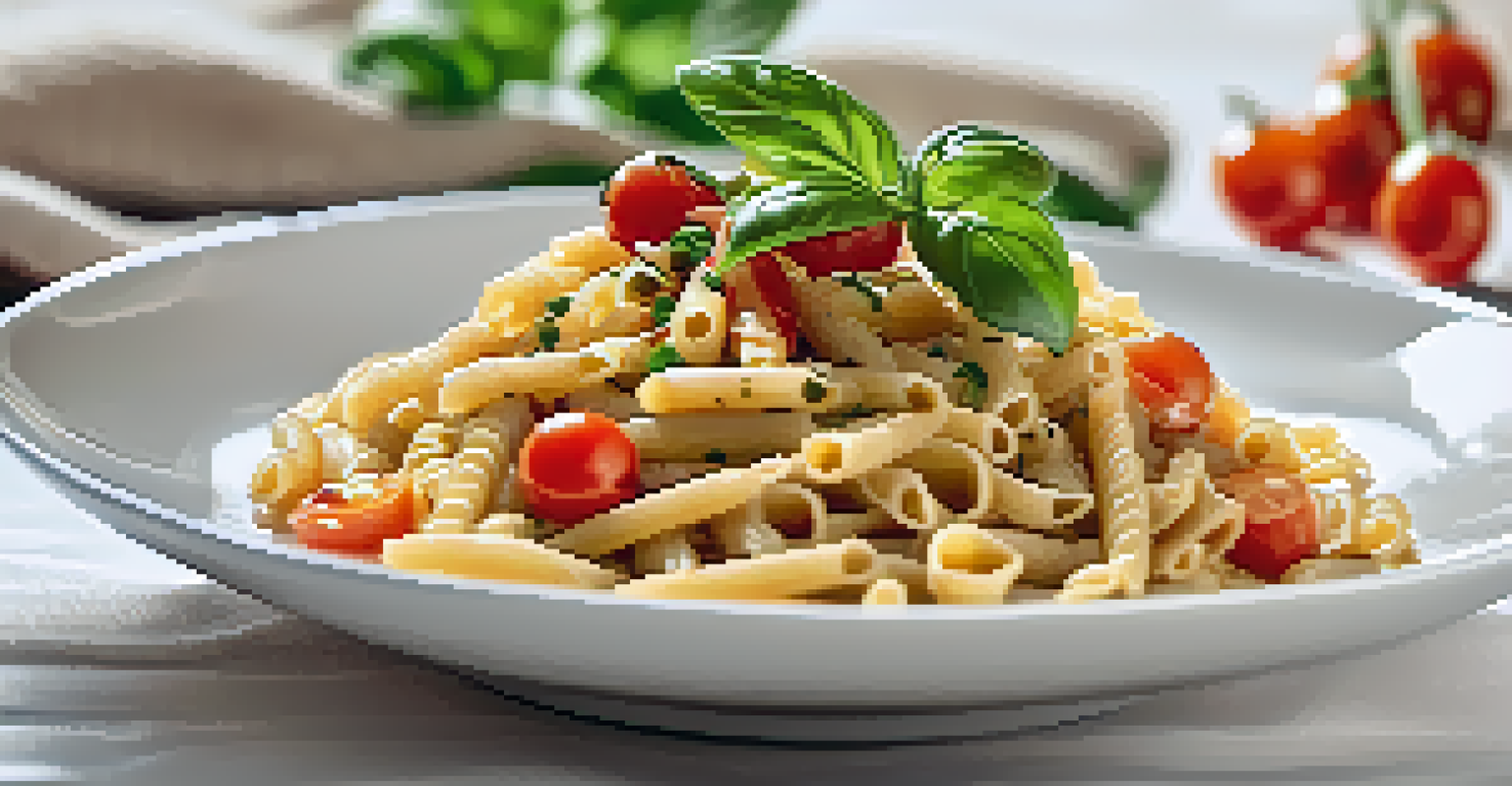The Rise of Alternative Grains in Vegetarian Cooking Today

Introduction to Alternative Grains in Vegetarian Cooking
In recent years, alternative grains have gained significant traction in the vegetarian cooking scene. Unlike traditional staples like wheat and rice, these grains offer unique flavors and nutritional benefits that enhance plant-based dishes. Ingredients such as quinoa, farro, and millet are not just trendy; they are reshaping how we think about vegetarian meals.
Let food be thy medicine and medicine be thy food.
The rise of alternative grains aligns with a growing awareness of health and sustainability. As more people seek to diversify their diets, these grains provide an exciting way to incorporate whole foods into everyday meals. With their varied textures and tastes, they invite creativity in the kitchen, making vegetarian cooking more vibrant than ever.
Moreover, many alternative grains are gluten-free, catering to those with dietary restrictions. This inclusivity broadens the appeal of vegetarian cooking, welcoming a wider audience to explore nutritious and delicious options.
Nutritional Benefits of Alternative Grains
Alternative grains come packed with a variety of nutrients that can elevate a vegetarian diet. For instance, quinoa is not only a complete protein, but it's also rich in fiber, which aids digestion. This makes it a fantastic substitute for more common grains, adding both health benefits and a nutty flavor to dishes.

Other grains like amaranth and teff are also nutritional powerhouses. Amaranth is known for its high iron content, while teff is an excellent source of calcium. By incorporating these grains, vegetarians can ensure they are obtaining essential vitamins and minerals that may sometimes be lacking in a plant-based diet.
Nutritional Power of Alternative Grains
Alternative grains like quinoa and amaranth provide essential nutrients that enhance a vegetarian diet.
In addition to their nutrient density, alternative grains often have lower glycemic indices compared to traditional grains. This means they can help maintain stable blood sugar levels, making them a smart choice for anyone looking to improve their overall health.
Culinary Versatility of Alternative Grains
One of the most exciting aspects of alternative grains is their culinary versatility. They can be used in salads, soups, stews, and even breakfast dishes, allowing for endless creativity in meal preparation. For example, farro works beautifully in a hearty grain salad, while millet can be transformed into a comforting porridge.
You are what you eat, so don’t be fast, cheap, easy, or fake.
In addition to being main ingredients, these grains can also serve as excellent side dishes. A simple preparation of quinoa with herbs and lemon can elevate any meal, providing a nutritious complement to roasted vegetables or plant-based proteins. This flexibility makes it easy for anyone to incorporate them into their cooking routine.
Moreover, alternative grains can be used to create gluten-free versions of popular dishes. For instance, gluten-free pasta made from lentils or chickpeas offers a delicious alternative that satisfies cravings without compromising dietary needs.
Sustainability and Alternative Grains
The shift towards alternative grains is not just a culinary trend; it's also a response to sustainability concerns. Many of these grains are more resilient and require fewer resources than traditional crops, making them a more sustainable choice for consumers. For instance, quinoa can thrive in harsh conditions where other crops may fail, reducing agricultural stress.
Additionally, the cultivation of alternative grains often promotes biodiversity. By diversifying crops, farmers can improve soil health and reduce reliance on chemical inputs. This aligns with the values of many vegetarians who prioritize environmentally friendly practices in their food choices.
Culinary Versatility in Cooking
These grains can be creatively used in various dishes, from salads to gluten-free pasta, enhancing meal options.
As consumers become more conscious of their impact on the planet, the demand for sustainable options will likely continue to grow. Alternative grains offer a tangible way to support sustainable agriculture while enjoying delicious and nutritious meals.
Exploring Global Cuisines with Alternative Grains
Alternative grains have deep roots in various cultures around the world, making them a gateway to exploring global cuisines. Dishes like Ethiopian injera made from teff or Indian khichdi made from millet highlight the rich histories of these grains. By incorporating them into vegetarian cooking, we can celebrate culinary traditions while making them more accessible.
This exploration of global flavors encourages home cooks to step outside their comfort zones. Using grains like buckwheat or spelt opens up a world of new recipes and techniques, allowing for a richer culinary experience. It's about embracing diversity not just on the plate, but also in our cooking practices.
As people experiment with alternative grains, they also contribute to a broader understanding of food culture. This exchange fosters appreciation for the ingredients and dishes that may have previously been overlooked in mainstream cooking.
Challenges of Incorporating Alternative Grains
Despite their many benefits, incorporating alternative grains into everyday cooking can come with challenges. One common hurdle is the unfamiliarity with cooking methods and flavor pairings. For instance, some might find it daunting to prepare grains like farro or freekeh without guidance.
Additionally, the availability of alternative grains can vary depending on location. While larger grocery stores may stock a variety of options, smaller markets might not have the same selection. This can make it difficult for some home cooks to experiment with these ingredients without prior planning.
Sustainability and Food Choices
Opting for alternative grains supports sustainable agricultural practices and promotes biodiversity.
However, with the rise of online grocery shopping and specialty stores, accessing these grains is becoming easier. As awareness grows, so does the support for local suppliers who focus on sustainable and diverse products, making it easier for everyone to enjoy the benefits of alternative grains.
Conclusion: The Future of Alternative Grains in Vegetarian Cooking
As the culinary landscape continues to evolve, alternative grains are poised to play a significant role in vegetarian cooking. Their nutritional benefits, sustainability, and versatility make them ideal for health-conscious consumers and adventurous cooks alike. The increasing interest in plant-based diets only amplifies their importance in the kitchen.
Looking ahead, we can expect to see even more innovative recipes and products featuring these grains. From ready-to-eat meals to gourmet restaurant dishes, alternative grains will likely become a staple ingredient on menus around the world.

Ultimately, the rise of alternative grains is about more than just food; it's a movement towards healthier, more sustainable eating habits. As we embrace these grains, we open ourselves to new flavors, cultures, and a deeper connection with our food.